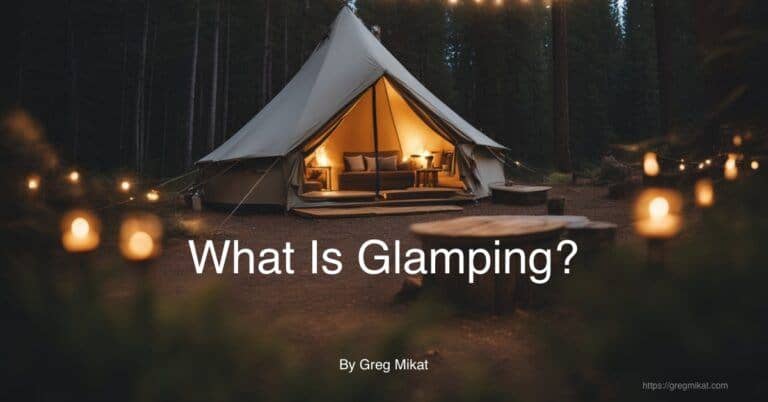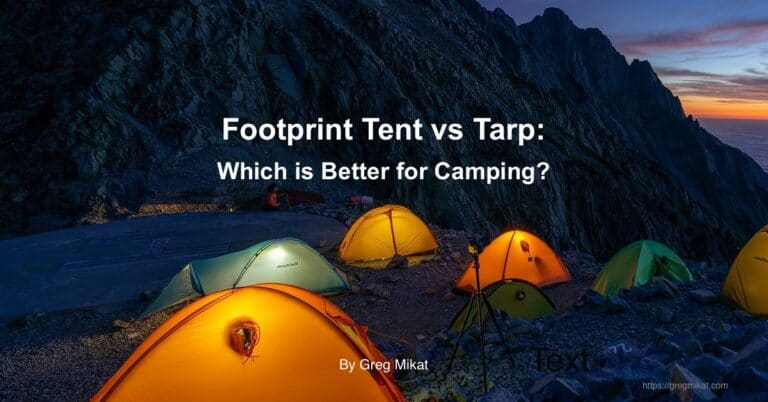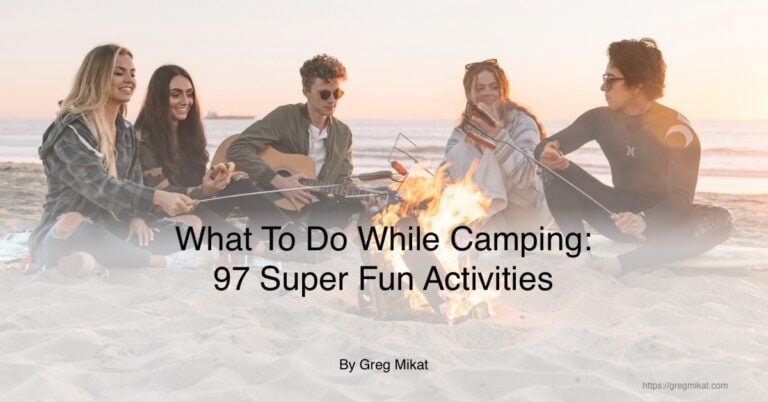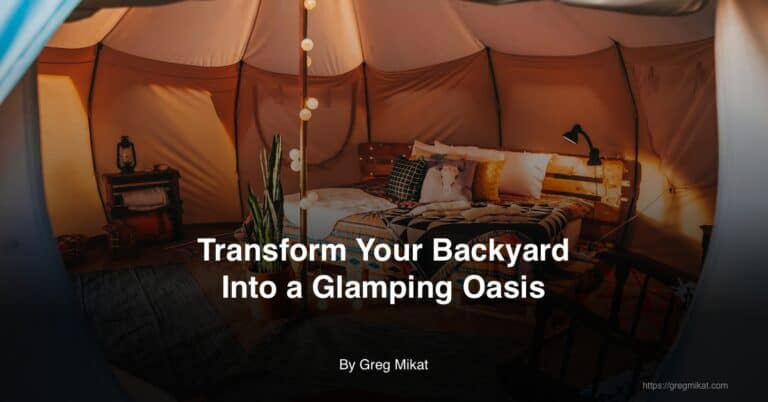Glamping vs Camping Differences: Which is Better for You?
Glamping has taken the outdoor experience to a level where comfort meets nature. It allows you to enjoy the great outdoors without sacrificing the luxury one might find in a high-end hotel. Glamping offers a unique way to appreciate nature while enjoying the comforts of home.
On the other hand, camping is all about getting back to nature and embracing the wilderness with minimal comforts. It’s a chance to disconnect from the modern world and engage with the environment in its rawest form. You set up your tent, cook over a fire or portable stove, and find solace in the simplicity and tranquility that the great outdoors provides.
Whether you opt for the accessible luxury of glamping or the traditional, self-reliant method of camping, both provide unforgettable ways to experience the wonders of nature.
Defining the Experience
In recent years, your choices for engaging with the wilderness have expanded, offering you experiences that range from the rustic charm of traditional camping to the comforts of glamping.
What is Glamping?
Glamping, short for glamorous camping, is your upscale approach to enjoying the outdoors. It brings together the adventure of being in nature with the opulence of modern conveniences. Glamping accommodations can vary widely.
What is Camping?
Camping refers to your conventional way of staying outdoors, often requiring you to set up your shelter. The essence of camping lies in its simplicity and the hands-on adventure it provides.
The difference between glamping and camping will focus on your preference for comfort versus a rugged outdoor experience.
Accommodations Comparison
When choosing between glamping and camping, your decision often comes down to the type of lodging you prefer.
Glamping Accommodations
Yurts: A circular tent structure originating from Central Asia, yurts in a glamping context often feature modern comforts such as plush bedding, furniture, and even heating and lighting.
Luxury Tents: Larger than yurts, luxury tents can include actual beds, fine linens, and even en-suite bathrooms. These tents are designed for comfort and are often styled like safari tents.
Cabins and Tree houses: Glamping may also offer cabins, often equipped with full kitchens and bathrooms, or tree houses, providing a unique, elevated perspective of the surroundings.
RVs: Some glamping sites have stationary RVs that come with all the comforts of home, including a kitchen, bathroom, and beds.
- Amenities: Glamping is known for additional luxuries, such as private decks, hot tubs, and sometimes even room service.
- Environment: While glamping, you have the convenience of shelter that shields you from the elements, yet many sites still offer a strong connection to the natural environment.
Camping Accommodations
Tents: Common tents range from small pop-ups just big enough for a sleeping bag to larger, more robust canvas tents for family camping.
- Tent Camping: You pitch a tent and sleep in sleeping bags, usually with minimal creature comforts.
- Backcountry Camping: You carry all your essentials in a backpack to a remote location, completely immersing in the wilderness.
Camping Cabins: Simpler than glamping cabins, these are usually small and provide basic shelter without the frills of high-end lodgings.
Cars and Small Campers: While camping, you’ll likely sleep on a foam pad or air mattress inside your tent, the bed of a truck, or a lesser foam mattress in your camper rather than in an actual bed. Larger family tents may have room for several people to sleep.
- Amenities: Camping typically involves more basic provisions. You may not have electricity or running water at your site, and communal facilities are common.
- Environment: Your shelter is likely less insulated from the elements, making your experience more rugged and closer to the natural environment.
Comfort and Convenience
In the realm of outdoor overnight stays, your experience with comfort and convenience can differ widely between glamping and camping. This section examines what you can expect in each scenario, focusing on the physical comforts and amenities provided.
Comfort in Glamping
Glamping offers you a level of comfort that closely rivals that of a hotel. Your sleeping arrangements usually include Comfortable beds such as queen-sized mattresses or high-quality air mattresses, often adorned with plush blankets and fine linens.
The inclusion of upscale comforts, like electricity, running water, and actual toilets, contributes to a home-like experience in a natural setting.
- Sleeping: Comfortable beds (mattresses, air beds)
- Amenities: Electricity, Plumbing (running water, actual toilet)
Many glamping sites provide private bathroom facilities, ensuring that you don’t have to sacrifice privacy or convenience. Coupled with the availability of hot tubs and other creature comforts, your glamping experience can be as relaxing as lounging in a boutique hotel, surrounded by the natural world.
- Bathroom Facilities: Private bathroom (soft towels)
- Extras: Hot tubs, deluxe bedding
Comfort in Camping
When you opt for the traditional camping experience, comfort centers around the gear you bring and your preparedness. Sleeping bags paired with a insulating pad or cot are common, providing varying degrees of cushioning from the ground. It’s crucial to select a comfortable sleeping bag and an insulated pad to ensure a restful night.
- Sleeping: Sleeping bags, Foam pads or Cots
More often than not though, a walk down the path to an outhouse can be expected. It’s a more rugged experience, but there’s a unique sense of satisfaction that comes from your self-sufficiency in the wild.
- Bathroom Facilities: Campsite resources (vary by location)
- Basics: No electricity (bring solar chargers, battery-powered lights)
Amenities
When you’re deciding between glamping and camping, consider how the resources and features of each will affect your comfort and experience in the outdoors.
Amenities of Glamping
Glamping sites often provide you with a variety of modern conveniences that are not traditionally found in camping. Here, you can expect to find fully-equipped kitchens or kitchenettes, which include cooking appliances, refrigerators, and sometimes even dishwashers. Your glamping accommodation may include private restrooms with hot-water showers and flushing toilets, ensuring high levels of hygiene and comfort.
- Kitchen/Kitchenettes: Usually includes stoves, refrigerators, and sometimes microwaves or coffee makers.
- Restrooms: Often resemble those in hotels, with full plumbing.
Some glamping locations offer a level of opulence akin to boutique hotels, with niceties like:
- Luxury Bedding: Comfortable beds with high-quality linens.
- Climate Control: Air conditioning or heating for a pleasant stay regardless of weather.
- Spa Facilities: Hot tubs or saunas may be available.
Amenities of Camping
Camping places you closer to the wild and typically involves more basic features that provide a rustic experience. Your kitchen may be an open fire or a portable stove; water often needs to be fetched from a water pump or nearby streams. Restroom facilities might be limited to shared outhouses, and showers could be non-existent or communal.
- Kitchen: Fire pit, portable stoves, and coolers that you bring along for food storage.
- Restrooms: Public outhouses or portable toilets, seldom with flushing capabilities.
The contrast in comforts:
| Glamping | Camping |
|---|---|
| Private bathrooms with plumbing | Communal restrooms or outhouses |
| Equipped kitchens or kitchenettes | Fire pits and portable cooking equipment |
| Comfortable bedding and climate control | Sleeping bags and enduring the elements |
Remember, these provisions can vary widely depending on the location and level of camping or glamping you choose.
Exploring the Outdoors
When you step outside into the great outdoors, whether through glamping or camping, you engage with the environment in distinct ways. Each approach offers a unique blend of comfort and authenticity, impacting your experience of forests, beaches, and national parks.
Glamping and Connection with Nature
Glamping provides you with a luxurious outdoor experience. Your connection with the landscape is seamless yet polished, set in beautiful natural surroundings like:
- Forests: Imagine waking up to the sounds of birds from the comfort of a queen-sized bed.
- Beaches: Enjoy the coastal views without sacrificing creature comforts.
- National Parks: Experience the wonders of national parks with guided tours and well-maintained trails.
Glamping sites are often purposefully designed to blend with the environment, maximizing your immersion in the outdoors while preserving the natural habitat.
Camping and Wilderness Experience
In contrast, camping offers a more traditional approach to enjoying the wilderness. You pitch your tent or set up a campsite in various terrains, which could include:
- Remote Locations: Find solitude and serenity away from crowded places.
- Forests and Beaches: Sleep under the stars and wake up to unfiltered sounds of wind or waves.
- National Parks: Connect deeply with the environment by staying in less developed areas.
Camping requires you to be hands-on, fostering a sense of self-sufficiency and a deeper bond with the outdoors. It is an authentic way to experience the wild, offering solitude and a break from the hustle of everyday life.
Preparation and Gear
When planning an outdoor retreat, the right gear is crucial for comfort and practicality, whether you’re glamping or camping. Your preparation will differ significantly based on your choice, as glamping often involves seeking creature comforts, while camping requires a more hands-on and minimalist approach.
Glamping Gear and Preparation
For destination glamping, often resembling a hotel in the wilderness, all you need to bring is your clothing and gear for the activities you have planned.
- Accommodation: Your shelter, which may be provided for you, can range from a high-end tent to a cabin, yurt, or Airstream trailer. These often come pre-equipped with beds and linen.
- Utilities: Glamping sites typically include electricity, water, and a private bathroom.
- Cooking: Kitchen facilities are often included, with everything from a refrigerator to a stove.
| Glamping Essentials | Description |
|---|---|
| Luxurious tent or cabin | Pre-set with bedding and furnishings |
| Cooking equipment | Often includes kitchenette or barbecue |
| Climate control | May have heating or air conditioning |
| Lighting | Electric lights and lanterns |
Camping Gear and Needs
Your gear should be tailored to a more rugged experience, emphasizing self-sufficiency. Bring everything you need or you will learn how to do without!
- Shelter: Bring your own tent or hammock. Ensure you have the tent stakes and a rainfly for protection.
- Sleeping: Invest in a good-quality sleeping bag suited to the climate, plus an insulating pad.
- Backpacking Essentials: A durable backpack is necessary to carry gear, food, and a campfire cooking set if you plan to cook your meals.
| Camping Essentials | Description |
|---|---|
| Tent or hammock | Requires necessary setup equipment |
| Sleeping bag | Fiber fill or down, ensure it’s rated for the temperature |
| Backpack | For carrying all essential gear to the backcountry |
| Cooking equipment | Portable stove, fuel, all necessary utensils |
Remember to pack according to the style of your trip – glamping for ease and comfort, camping for a traditional outdoor excursion.
Food and Meals
When exploring glamping and camping, your food experience varies notably from the convenience of prepared meals to the hands-on approach of cooking over a fire or camp stove.
Meals in Glamping
Glamping accommodations usually provide access to a kitchen equipped with appliances, where you can prepare your own meals with ease. Alternatively, many glamping sites offer all-inclusive options, where meals are prepared for you. This can range from gourmet offerings to robust, hearty fare, similar to what you might find at a higher-end resort.
Preparation Resources:
- Standard kitchen appliances (fridge, stove, oven, etc.)
- Utensils and dishware provided
- Dining area
Meal Options:
- Prepared by on-site chefs
- Cooked by you with your own or provided ingredients
- Local dining establishments
Cooking While Camping
When you’re camping, meal preparation is part of the experience. You’ll likely bring your rations or ingredients and cook over a campfire or portable stove. This requires more planning, as you need to ensure you have all necessary supplies and equipment. From fire to roast hot dogs to a camp stove for a more controlled cooking experience, your skills will dictate the complexity of the meals you create.
Preparation Resources:
- Fire source (campfire, camp stove)
- Cooking utensils (pots, pans, spatula, etc.)
- Coolers for food storage
Suggestion for Meals:
- Pre-packaged meals (easy and quick)
- Raw ingredients for recipe-based cooking
- Locally sourced produce for an authentic experience
Cost Considerations
When examining the costs associated with outdoor stays, you’ll find that both glamping and camping span a range of price points depending on the level of extravagance or budget-consciousness you’re targeting.
Glamping Budgeting
Glamping can significantly vary in cost but tends to be more expensive due to the luxury provided. A basic glamping setup, including a large canvas tent with a real bed and basic furnishings, could start around $150 per night.
More luxurious options could include air conditioning, high-end bedding, and gourmet food services, with prices rising accordingly, ranging from $300 to over $3000 per night. You need to consider the full range of glamping luxuries you desire when establishing your budget.
| Glamping Comfort Level | Estimated Cost Per Night |
|---|---|
| Basic Comfort | $100- $200 |
| Moderate Luxury | $200 – $350 |
| High-End Luxury | $350 – $4000+ |
Camping on a Budget
In contrast, camping is typically considered a more budget-friendly option, with costs primarily surrounding gear investment and campsite fees.
If you already possess the necessary equipment, such as a tent, sleeping bags, and cooking gear, your main expense will be the campsite fee which can range from $10 to $50 per night for basic public parks.
For those needing to purchase equipment, initial costs could range from $100 for basic gear to over $500 for higher quality items, which then can be used for subsequent trips.
| Camping Expense | Potential Cost |
|---|---|
| Campsite Fee | $10 – $50 per night |
| Basic Gear Investment | $100 – $500+ (one-time) |
When planning either a glamping or camping trip, it’s important to factor in additional potential expenses like travel, food, and activity fees, which will add to the overall cost of your adventure.
Traveler’s Experiences
In exploring different styles of embracing the outdoors, you’ll find varying narratives from travelers. Each tale reflects a unique blend of comfort and adventure.
The Glamper’s Tale
You step into a spacious canvas tent with a real bed, a chandelier made from antlers hanging above, and a plush armchair beside a wood stove—a cozy retreat in the wilderness. Your experience as a glamper combines the essence of camping with the comforts of home. You enjoy the serene beauty of the wilderness during the day with outdoor activities like guided hikes or canoeing. You return to a fully cooked meal at night beside a roaring firepit. Glamper experiences center around both nature and comfort:
| Outdoor Activity | Glamper Experience |
|---|---|
| Guided nature walks | Enjoy with the assurance of a nearby guide |
| Lakeside yoga | Practice with provided mats and serene views |
| Star gazing | Relax on designer deck chairs with warm blankets |
The Camper’s Journey
As you zip up your tent, the sounds of the wilderness lull you to sleep. Your camper’s journey might involve backpacking through trails with everything you need on your back or staying in a more rustic setting at an RV park. The emphasis is on making a direct connection with the natural world, even if it means forgoing some creature comforts. Adventure is a common thread for campers, as they immerse in natural experiences through various activities:
| Outdoor Activity | Camper Experience |
|---|---|
| Setting up the tent | A practical skill and part of the camping ritual |
| Collecting Firewood | Preparing for a night of storytelling around the fire |
| Fishing or foraging | A way to sustain yourself and engage with the environment |
Embracing the simplicity of the outdoors is at the heart of the camper’s philosophy, letting the raw beauty of nature stand front and center.
Frequently Asked Questions
This section answers common inquiries about the disparities and costs between glamping and traditional camping, along with their respective advantages, disadvantages, and experiences.




